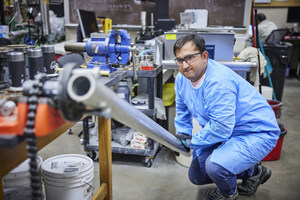There has been a great deal of excitement in the climate science world around hydrogen-based energy as an alternative to directly combusting fossil fuel-based sources for energy. The goal of hydrogen-energy research is to produce it cheaply, without greenhouse gas emissions and at scale from either water or hydrogen-rich organic compounds. However, there are several methods by which this conversion can take place which all come with their own benefits and costs.
Hydrogen production by pyrolysis – breaking apart natural gas into hydrogen and solid carbon – is a particularly enticing science and engineering goal, as this method produces H2 with a low carbon emission intensity footprint and has an additional benefit of creating solid carbon byproducts, with potentially high market value of their own.
"If you were to meet a significant fraction of our energy needs by producing H2 and solid carbon, that would create a huge quantity of excess solid carbon," Crossley said. "What do we do with all this carbon? How do we gain value from it? How do we benefit society? In lieu of creating new mountains and islands of solid carbon, what can we actually do?"
Currently, performance carbon materials such as carbon fibers and nanotubes are expensive to produce and so have been relegated to high-end or niche applications like making lighter cars, drones or advanced composite materials.
"Now we're talking about creating a byproduct from the energy that changes everything," Crossley said. "That means that we need to find all ways that we can use carbons and tweak them such that they benefit society in a variety of ways and we're not wasting the valuable resources that we put into the process."
They're studying many different applications, like soil amendments to sequester long-lived carbon in the environment and help crops grow and evaluating their use as water filtration systems to help clean water.
"We are investigating ways to make advanced pavements and asphalts, materials for batteries and fuel cells, and other next-generation technologies that possibly wouldn't have made sense unless this was a byproduct from the energy industry," he added.
Learn more at https://bit.ly/OU-RII
SOURCE University of Oklahoma








Share this article